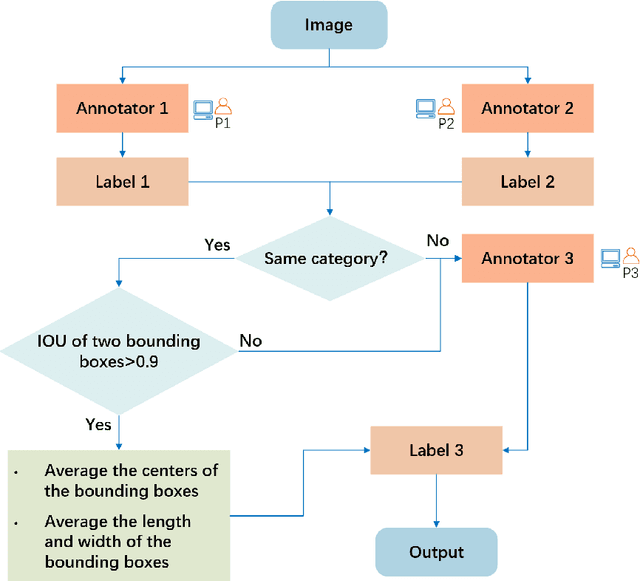Xiaoliang Tan
BFA-YOLO: Balanced multiscale object detection network for multi-view building facade attachments detection
Sep 06, 2024



Abstract:Detection of building facade attachments such as doors, windows, balconies, air conditioner units, billboards, and glass curtain walls plays a pivotal role in numerous applications. Building facade attachments detection aids in vbuilding information modeling (BIM) construction and meeting Level of Detail 3 (LOD3) standards. Yet, it faces challenges like uneven object distribution, small object detection difficulty, and background interference. To counter these, we propose BFA-YOLO, a model for detecting facade attachments in multi-view images. BFA-YOLO incorporates three novel innovations: the Feature Balanced Spindle Module (FBSM) for addressing uneven distribution, the Target Dynamic Alignment Task Detection Head (TDATH) aimed at improving small object detection, and the Position Memory Enhanced Self-Attention Mechanism (PMESA) to combat background interference, with each component specifically designed to solve its corresponding challenge. Detection efficacy of deep network models deeply depends on the dataset's characteristics. Existing open source datasets related to building facades are limited by their single perspective, small image pool, and incomplete category coverage. We propose a novel method for building facade attachments detection dataset construction and construct the BFA-3D dataset for facade attachments detection. The BFA-3D dataset features multi-view, accurate labels, diverse categories, and detailed classification. BFA-YOLO surpasses YOLOv8 by 1.8% and 2.9% in mAP@0.5 on the multi-view BFA-3D and street-view Facade-WHU datasets, respectively. These results underscore BFA-YOLO's superior performance in detecting facade attachments.
LMFNet: An Efficient Multimodal Fusion Approach for Semantic Segmentation in High-Resolution Remote Sensing
Apr 21, 2024



Abstract:Despite the rapid evolution of semantic segmentation for land cover classification in high-resolution remote sensing imagery, integrating multiple data modalities such as Digital Surface Model (DSM), RGB, and Near-infrared (NIR) remains a challenge. Current methods often process only two types of data, missing out on the rich information that additional modalities can provide. Addressing this gap, we propose a novel \textbf{L}ightweight \textbf{M}ultimodal data \textbf{F}usion \textbf{Net}work (LMFNet) to accomplish the tasks of fusion and semantic segmentation of multimodal remote sensing images. LMFNet uniquely accommodates various data types simultaneously, including RGB, NirRG, and DSM, through a weight-sharing, multi-branch vision transformer that minimizes parameter count while ensuring robust feature extraction. Our proposed multimodal fusion module integrates a \textit{Multimodal Feature Fusion Reconstruction Layer} and \textit{Multimodal Feature Self-Attention Fusion Layer}, which can reconstruct and fuse multimodal features. Extensive testing on public datasets such as US3D, ISPRS Potsdam, and ISPRS Vaihingen demonstrates the effectiveness of LMFNet. Specifically, it achieves a mean Intersection over Union ($mIoU$) of 85.09\% on the US3D dataset, marking a significant improvement over existing methods. Compared to unimodal approaches, LMFNet shows a 10\% enhancement in $mIoU$ with only a 0.5M increase in parameter count. Furthermore, against bimodal methods, our approach with trilateral inputs enhances $mIoU$ by 0.46 percentage points.
S3Net: Innovating Stereo Matching and Semantic Segmentation with a Single-Branch Semantic Stereo Network in Satellite Epipolar Imagery
Jan 03, 2024



Abstract:Stereo matching and semantic segmentation are significant tasks in binocular satellite 3D reconstruction. However, previous studies primarily view these as independent parallel tasks, lacking an integrated multitask learning framework. This work introduces a solution, the Single-branch Semantic Stereo Network (S3Net), which innovatively combines semantic segmentation and stereo matching using Self-Fuse and Mutual-Fuse modules. Unlike preceding methods that utilize semantic or disparity information independently, our method dentifies and leverages the intrinsic link between these two tasks, leading to a more accurate understanding of semantic information and disparity estimation. Comparative testing on the US3D dataset proves the effectiveness of our S3Net. Our model improves the mIoU in semantic segmentation from 61.38 to 67.39, and reduces the D1-Error and average endpoint error (EPE) in disparity estimation from 10.051 to 9.579 and 1.439 to 1.403 respectively, surpassing existing competitive methods. Our codes are available at:https://github.com/CVEO/S3Net.
Segment Change Model (SCM) for Unsupervised Change detection in VHR Remote Sensing Images: a Case Study of Buildings
Dec 27, 2023Abstract:The field of Remote Sensing (RS) widely employs Change Detection (CD) on very-high-resolution (VHR) images. A majority of extant deep-learning-based methods hinge on annotated samples to complete the CD process. Recently, the emergence of Vision Foundation Model (VFM) enables zero-shot predictions in particular vision tasks. In this work, we propose an unsupervised CD method named Segment Change Model (SCM), built upon the Segment Anything Model (SAM) and Contrastive Language-Image Pre-training (CLIP). Our method recalibrates features extracted at different scales and integrates them in a top-down manner to enhance discriminative change edges. We further design an innovative Piecewise Semantic Attention (PSA) scheme, which can offer semantic representation without training, thereby minimize pseudo change phenomenon. Through conducting experiments on two public datasets, the proposed SCM increases the mIoU from 46.09% to 53.67% on the LEVIR-CD dataset, and from 47.56% to 52.14% on the WHU-CD dataset. Our codes are available at https://github.com/StephenApX/UCD-SCM.
 Add to Chrome
Add to Chrome Add to Firefox
Add to Firefox Add to Edge
Add to Edge